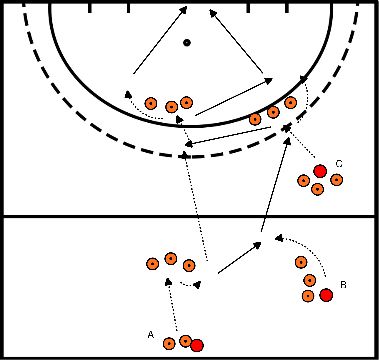Hockey drills for technique ball control
- A plays the ball to the incoming B
- B rebounds the ball
- A drives a little
- B offers himself wide and A plays the ball into the space to B
- Because of B's running action outside, C makes space by running inside.
- B accelerates during his running action with the ball over the back line.
- C has gone towards the dot
- B passes, C rounds off (one-touch).
Variation: Exercise 2x.
Start with a three-run.
- A floats with the ball, when A is halfway, he pushes the ball out of the run to B.
- B does the same (to C)
- etc.
- Apply differentiation.
Possibly after this warm-up play another game of possession.
Purpose
: Various technical forms to warm up.
Format
:The exercise can be set up one-sided or two-sided. This depends on the number of players in the training.
- At point A, the player makes a drag and passes the pawns. Then he passes to the player at point B.
- The player at point B takes the ball and dribbles to point C. From there he passes to the player at point C.
- The player receives the ball and turns towards the goal, completing the pass
- Before turning, you run after the ball. Point D rejoins point A again.
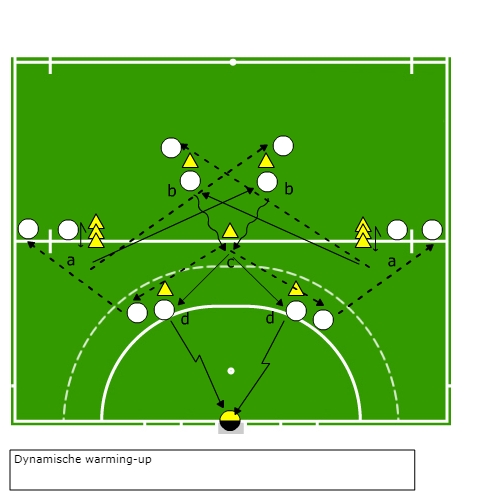
Variations:
- You can set up the exercise single-sided and double-sided.
- You can also choose to warm up the goalkeeper in this way.
- At C, you can switch sides. If you are coming from the right, play the ball to the right, so that you can practise from both sides.
Points of attention:
- This is a good time to look at different techniques of your players and polish them.
- When turning and dribbling, the ball must stay on the stick.
- There is only one point at C, so players should not get in each other's way and look for the next ball to enter play.
- All balls are played into the forehand of the teammates.
Goal
: The goal of this exercise is to actively pass between the ball and the defender, making yourself playable
Set-up
:In order to run this exercise properly, you need a minimum number of players. You can play with this when you make the exercise one station shorter.
- The player at B starts walking and runs with a curve past the orange pawns. By doing so, he offers himself for play.
- The player at A plays into the run-in player and runs around the indicated cones towards point B.
- The player with C runs in a curve around the orange cones. The moment of starting is important. He pays attention to how far the player at point B is.
- The player at point B plays into the player who left from point C.
- The player at point C receives the ball in front of the orange cones, runs with it into the circle and rounds the goal.
- The player who completed runs around the cones back to point A.
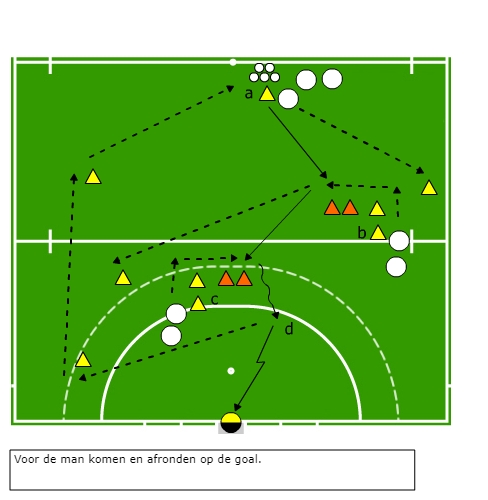
Variations:
- By removing one station, you can make the exercise smaller, requiring fewer players.
- The position from which the player who passes runs in front of the man starts can be changed. You can e.g. move point B more to the inside of the play area, making the direction of play different.
- You can also create an extra station near the goal for someone who is about to tip in Please note that you will need several players for this.
Points of attention:
- When floating, the ball is attached to the stick. This makes it almost impossible to take the ball away without committing a foul.
- When offering the ball, you have to make yourself wide so you can get between the ball and the defender
- Starting the run can be difficult to time, so pay extra attention to this
- The passes should be made in front of the orange cones, so that you are clearly running in front of the man
Passing in the run and finishing on goal
Objective:
Being able to combine, run with and without the ball, turn open, pass and finish on goal.
Set-up:
For the exercise at least 2 participants are active. When you also work with a goalkeeper, a third person is active.
- Player 1 has no ball and starts running from point A to point B.
- Player 2 stands on point E and stays there during the exercise. Player 2 plays the ball to player 1 in the run.
- When player 1 arrives at point B, he plays the ball back to player 2 and continues to point C.
- Player 2 plays the ball to point C so that player 1 can take it there.
- Player 1 turns inside and walks to the head of the circle.
- At point D, player 1 rounds the goal and runs out the exercise on the right side so he can run around point C and take over player 2's spot.
- After handing off player 2's final pass, he runs to point A and closes in at the back.
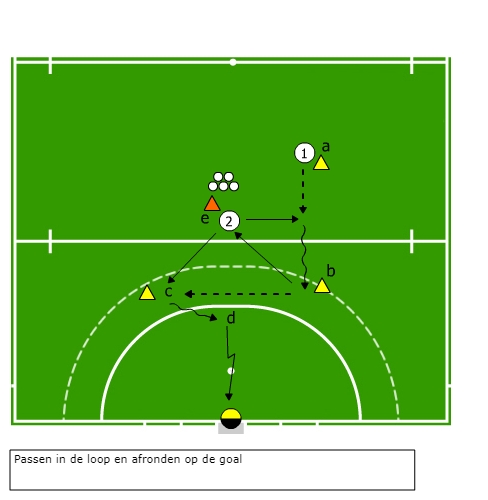
Variations:
- At point B, instead of passing the ball directly to player 2, player 1 can do a Swivel. In this way the player learns to put his body between the ball and the opponent.
- Player 2 can also pass to player 1 in the run from point B to point C. This trains you even more on passing and taking on in the run.
- The whole exercise can also be done in mirror image.
- Instead of one player on point E you can also have two different players make the pass. In that case, after the first pass, player 2 runs through and another player takes the ball and passes it to point C.
- If player 1 is fast enough, player 2 can also bounce the ball from point E to point C. This increases the difficulty by increasing the speed and adding the bounce.
- Player 1 plays the ball with a hard push into the attacker who has come running from the spot.
- The attacker takes the ball strongly and passes it back.
- Player 1 plays the ball to the side.
- The player on the side plays the ball directly to the corner.
- Now the team can shift via the left.
Finish the training with a match shape on a half pitch
You can adjust the width of the field depending on the size of your team at the training.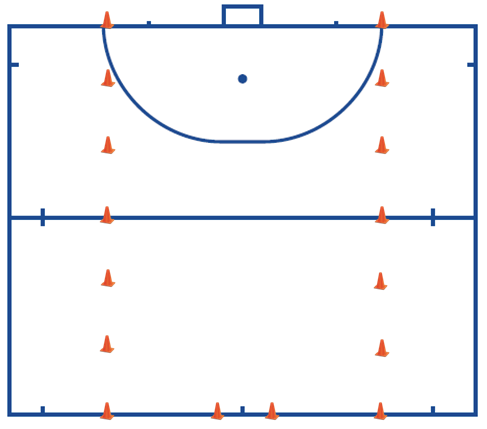
- Position the pawns as shown in the figure
- Spread the balls on pylons C and D.
- In this exercise you place a player on the pylons C and D.
- The rest of the team lines up at the A-post.
- From A the player walks around the pylon
- From the pylon, the player makes a sideways movement, facing the ball (facing C)
- Player C plays the ball into the forehand of A
- A takes the ball and turns to the right to open
- A runs towards the circle and finishes on goal.
- From here he runs to D and receives another ball.
- The player turns open to the left and again finishes on goal.
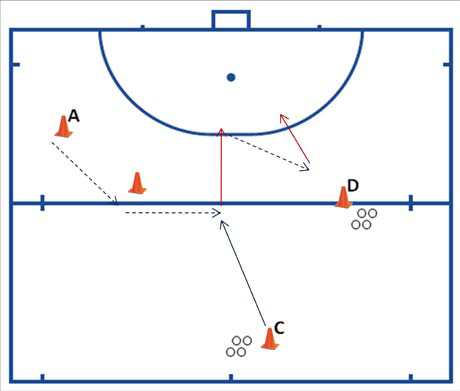

Two teams with substitutes, substitutions are made when a goal is scored.
Each person defends a goal, on each field there are 5 goals, so there are also 5 people who defend these goals.
If a goal is scored in your goal, you have to sit on the sidelines and you become a substitute. A new player (substitute) from the side enters the field and will defend the goal.
If a goal is scored, it is 1 point. The team that has the most points at the end of the game is the winner.
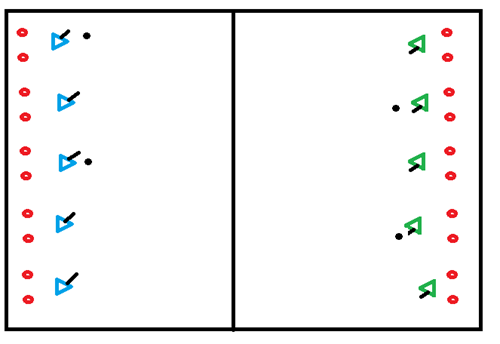
Overplaying to score
Two players continuously play over the ball until one student is so close to the goal that he can score in the goal.
Variation 2-1 situation:
Under pressure from the defender, the attackers must now play together and try to score. The defender can score a point by conquering the ball and then dribbling over the dead ball line. This is the short side without a goal.
- A starts with the ball.
- B runs in and gets the ball from A in the run.
- B runs on but meets a defender and passes the ball back to A.
- B then accelerates wide and gets the ball back from A immediately.
- B completes his line and walks in and around the circle with a shot for goal.
- Expanding on two sides
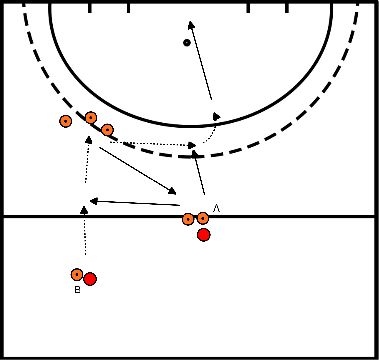
- A starts with the ball and runs up
- Encounters an opponent.
- B runs into the deep and gets a ball of A in the run
- C runs in and gets the ball from B in the run
- C takes the ball and runs towards the circle
- a player encounters an opponent there and passes the ball wide to the run-through A
- A walks in the direction of the circle and makes a choice or makes an action themselves
- Passes the pawns on the left and finishes on goal
- Or they choose to give the ball wide to the right to the run-through C
- Then C shoots at goal
